Installing a front on a dishwasher: useful tips + installation instructions
The difference between installing a built-in dishwasher and a freestanding model is that additional design is required for the front wall - the machine door.
It is assumed that the decorative panel is selected to match the surrounding interior, and then the facade is installed on the dishwasher.
If experienced craftsmen cope with this operation quickly, then for beginners the task seems quite difficult. To understand the features of facade installation, you should carefully study the instructions and become familiar with some of the installation nuances. And we will tell you about all this in detail in our article.
The content of the article:
Design features of built-in PMMs
The range of models integrated into kitchen units is much wider than their free-standing counterparts. This is explained by the principles of ergonomics and space saving inherent in the concept of constructing a kitchen interior. To get acquainted with the best brands specializing in the manufacture of built-in PMM models, please go to this link.
To install a built-in dishwasher, you will need a separate cabinet, or rather, a niche in the set. It differs from a regular kitchen cabinet in that it does not have a back wall or bottom.
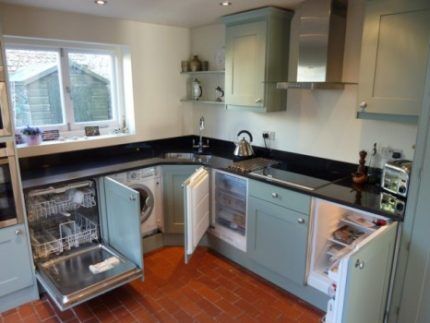
The machine is installed directly on the floor, on 3 or 4 support legs. The absence of a rear wall allows for free placement of the water supply and drain hoses.
The cabinet must have reliable walls to which the dishwasher body is attached, and a “roof” - the countertop. The front panel is not fixed to the walls, like conventional cabinets, but directly to the car door.
No need to experiment with fasteners: Manufacturers have provided installation features and prepared special holes for self-tapping screws. We provide detailed instructions on installing a built-in dishwasher model. brought here.
What is a facade for PMM? This is a decorative panel, most often made of the same material as the front surface of the entire kitchen unit. It is made from MDF, plastic, laminated chipboard, solid wood or combined materials.
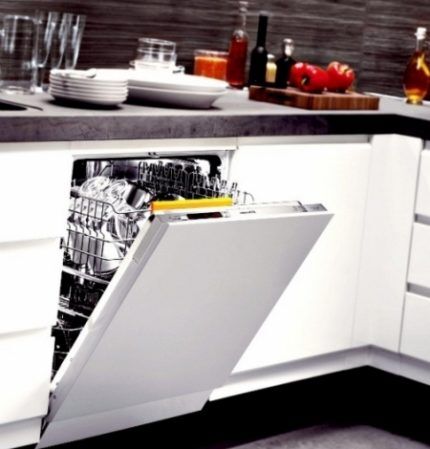
Where do you get decorative panels?
There are several ways to make it:
- ordered together with a kitchen set if the dimensions of the machine are known in advance;
- make it yourself from the doors of a disassembled kitchen cabinet;
- if there is no suitable “extra” facade, they are selected in a similar style and color design.
The first method is considered the most practical: when ordering, all dimensions of the car are taken into account, so the facade “fits” perfectly. But this method is not always applicable. We recommend that you read options for installing a dishwasher into the finished kitchen.
At what stage should the façade be attached?
The dishwasher is installed in several stages. The main one is considered connection to communications: water supply, sewerage system, dedicated power line.
Decorating the front side is usually done at the very end, when the rest of the work has already been completed.
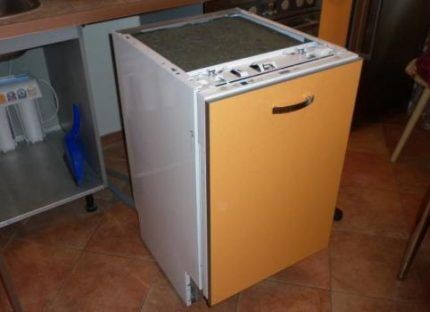
Is it possible to run the dishwasher without the decorative trim installed? It is not recommended to launch before installation work is completed for several reasons.
Only a dishwasher that is completely closed on all sides can fully perform its functions; in addition, the panel plays the role of an additional sound and heat insulator.
Sometimes they mask the machine first and then make the connection. This option is appropriate if there is a delay in connection for objective reasons, for example, at the same time the riser in the toilet is being replaced or a new power line is being laid.
In order not to waste time, decorate slowly.
Preparation of tools and materials
No special tools are required to secure the façade trim.
The same items that are used to install the dishwasher as a whole will be useful:
- drill;
- screwdriver;
- awl;
- screwdriver;
- tape measure or ruler;
- pencil or marker.
If you don’t have a power tool, then one screwdriver is enough - you can screw in the screws by hand if the holes for them are pre-drilled.
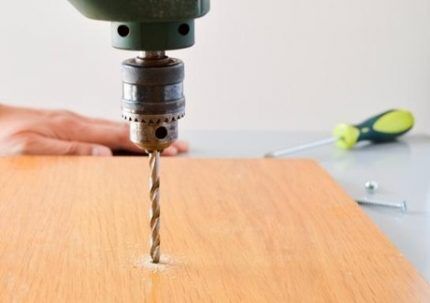
The work is simplified by the presence of a stencil for the façade overlay included in the delivery set. It is a large sheet of thin paper with marked attachment points.
The stencil is applied to the back of the decorative panel and mark the places where the screws are screwed in.
In addition to the tools, you will need double tape. Several “Velcro” pieces of tape will come in handy when you need to try on the facade. It is not recommended to immediately “mount” it on screws, since an error of 2-3 millimeters will mean all the work is in vain.
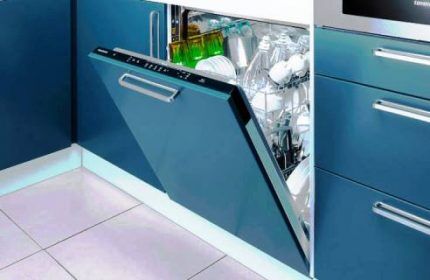
To ensure that the surfaces of the door and facade adjoin as tightly as possible, the heads of the screws should be recessed into the canvas.
It is easier to attach the workpiece than a homemade overlay. If you make the panel yourself, you may need carpentry tools, sandpaper for sanding, antiseptic impregnation and paint to finish the entire surface or just the ends.
DIY façade installation instructions
Having chosen the right time and prepared the tools, you can begin installation. However, during the installation process they often encounter unpleasant nuances that can delay the installation of the facade indefinitely.
Let's consider installation features that are best taken into account before starting work.
Stage #1 - determine the dimensions of the decorative panel
To find out the exact dimensions of the facade panel, you do not need to make calculations or draw diagrams - the manufacturer did everything for us.The instructions indicate all the indicators of interest - length, width, thickness, allowances.
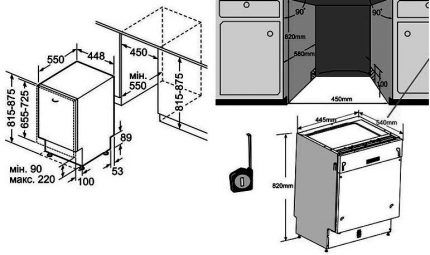
The width of the panel often matches the width of the dishwasher, since the door on the sides follows the parameters of the body. For example, for standard 60-centimeter models it is usually 598 mm, for 45-centimeter models – 448 mm (there are exceptions).
However, the height may vary. This depends on how the front of the adjacent kitchen cabinets is positioned.
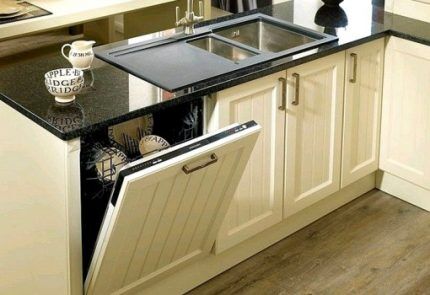
It is allowed to use a panel a few mm longer than the recommended length if the interior requires it. The main thing is that the extra millimeters do not interfere with opening the door at a right angle.
If the overlay touches the base, then it is left unchanged, and the edge of the base is cut out along the contour of the facade.
Stage #2 - choose the right fixation method
It is prohibited to ignore the manufacturer’s recommendations and experiment with methods of attaching the lining. If you fix the facade in your own way, it may fall off or “move” to the side over time.
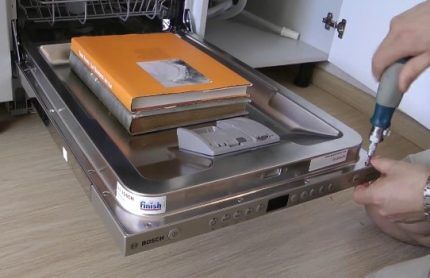
If you use nails instead of self-tapping screws, you will definitely have problems with dismantling. Expensive appliances last for decades and can “outlive” your kitchen set.
To replace the trim with a panel from new furniture, you will have to rip out the nails with the risk of deforming the surface of the door.
It is a mistake to fix the facade with glue. Two extremes can occur: either the glue will quickly lose its properties due to temperature changes, or it will “tightly” fix the pad to the machine. Both options are impractical.
Leaving pieces of adhesive tape as fastenings is also frivolous - the panel will fall off under its own weight at the very first vibrations of the unit.
Stage #3 - perform the installation sequentially
Before you begin hanging the front, you need to check how level the dishwasher is installed relative to the adjacent cabinets and countertop. An inclined position may result in the panel being secured crookedly.
The second point concerns the sizes - you should check again whether the length and width of the overlay are accurately adjusted. If everything is good, you can start.
Work order:
If, when closing the PMM door, no large gaps or backlashes are formed, tighten the fasteners, and the work can be considered complete.

After decorating the front side of the dishwasher, do not forget to make the side fastenings of the body.
To fix the side fastenings, you must first remove the upper basket for loading dishes, and then find the mounting holes and screw screws that are suitable in length from the side of the washing chamber into the side walls.
Professional installation advice
To avoid the most common mistakes, we suggest using recommendations from experienced furniture makers:
- be sure to use a tape measure or ruler, do not use your eye, do not be lazy to check the even position of the template and the panel - the appearance of the kitchen facade as a whole depends on this;
- choose the correct length of the screws: they must fit confidently and deeply enough into the panel surface, without coming out from the front side and not deforming it;
- when using a paper template, be sure to secure it on all sides;
- you can use a regular screwdriver, but using a screwdriver speeds up the process;
- Attach the handle, focusing on the location of the handles on adjacent cabinets, try to maintain not only the position (parallel/perpendicular to the floor), but also the height;
- To prevent the PMM door from closing during installation work, place a couple of large books or another heavy object, such as an iron, on it.
If a former cabinet door is used as a dishwasher front, when trying it on, pay attention to the location of the old holes.
It is important to ensure that the old mounting holes do not come into contact with the new ones, otherwise the screws may pop out and the panel may partially come off.
After completion of all installation work, you can begin operating the equipment. But first it is advisable to carefully study operating and maintenance rules dishwashers.
Conclusions and useful video on the topic
Video instructions help not only to imagine, but also to see the installation process in detail. We offer several examples of self-installation of a dishwasher façade.
Sequence of actions in the video with useful comments:
Installation of a panel from an IKEA set:
Testing of the installed facade:
Installing a decorative panel to disguise a dishwasher is a simple procedure that does not require special skills. However you need to act very carefully and skillfully, otherwise you can ruin the lining.
If you are not confident in your abilities, invite an experienced furniture maker to install it - he will cope with the installation work in 15 minutes.
Have you completed the façade installation yourself and want to share your success with other users? Share your experience in the comments to this article and the difficulties you encountered. Also add a photo of the finished work.




I decided not to do it myself, but to entrust this work to the masters. The wife was at home when the guys arrived. But, as it turned out, not everyone can be trusted; the master clearly had his hands in the wrong place. I installed the front so that when you open the door, it rests against the dishwasher and does not open completely. Yes, and they were fastened poorly, the facade is a little loose. I remodeled it myself, and during the work I realized that they had raised the dishwasher on legs a lot, which is why there was such a discrepancy.
How did your wife accept the job? It is clear that she is a woman, but it was necessary to see that the door did not rest against it. I will be making a façade on Bosch, everything is simple there according to templates.
At first, at our house we had a partially built-in dishwasher, this is when the façade is visible and not disguised as a kitchen unit. It was very beautiful, but this option involves more noise from a working dishwasher in the room. Not a washing machine, of course, but it still gets in the way, especially when the baby is sleeping at home. We changed it to a fully built-in version, it became much quieter. You can hardly hear anything now.So for anyone who needs maximum noiselessness, I recommend this option.
Can you tell me where I can get a paper template to accurately determine the mounting locations for a Bosch dishwasher?
Usually the installation instructions on a large sheet of paper are a template. Look carefully and you will see on it where to make the holes.
Good day. There is a need to hang the 40th facade on the 45th dishwasher. The question is, is it possible to insert screws into the holes not marked on the template (there is a control panel on the top - I’m afraid to break through some kind of board).